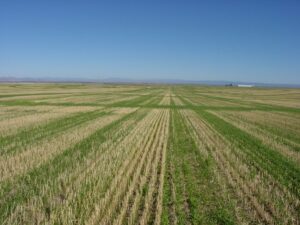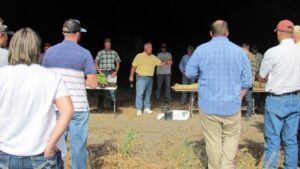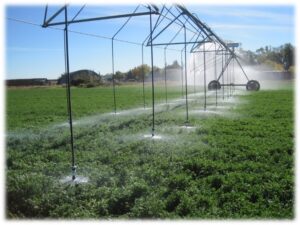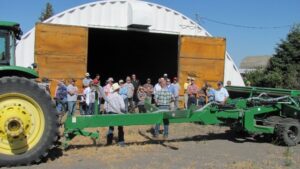2016 Annual Report for OW15-032
Madison County Healthy Soil Initiative
Summary
Madison Soil and Water Conservation District
conducts study to provide information on the benefits of practicing sound Soil Health practices
The Madison Soil & Water Conservation District located in Rexburg, Madison County, Idaho is conducting a study as part of the Madison County Soil Health Initiative to provide data that show sound Soil Health Practices such as Cover Crops, No-Tillage/Minimum Tillage, Variable Rate Fertilizing and diverse crop rotations will improve soil productivity, conserve irrigation water, increase resource savings, reduce erosion and be economically viable to agricultural producers. 2016 is the second year of this three year study. One of the main goals of this project is to reduce dependency on chemical applications. The second main goal is to improve the soils organic matter. It is very difficult for most producers to change their farming practices. They generally will say “I will watch my neighbor as they change practices to see how well the new practices are working. That way I don’t have to worry about crop failures if the new practices don’t work”. We are so thankful for the producers participating in this study who are on the cutting edge and willing to lead the way with cover crops, sound crop rotations, reducing and changing the way they fertilize and ever changing ways of irrigating crops. One of the benefits of this study is that other producers are interested in the study results.
Objectives/Performance Targets
Utilizing five agricultural producers and 14 fields, partnering with the Natural Resource Conservation Service, SIMPLOT Grower Solutions soil samples and tests were taken to establish a beginning base line for both physical and biological properties of the soil. These fields are being monitored for three years using same soil testing and analysis procedures to determine changes due to adoption of soil health practices. 2016 was our second year of monitoring. In addition, the producers are tracking and recording crop production inputs and outputs along with costs. These inputs are being collected each of the three years to determine the cost effectiveness of the soil health practices.
Accomplishments/Milestones
Data continues to be collected on the 14 test fields as was mentioned in the summary. The five growers participating in this study are doing some very innovative conservation practices, not necessarily new, but missing from their traditional production of many years. Because of mandatory water reduction through ever changing laws and regulations, Low Elevation Spray Applications (LESA) is beginning to move ahead that will potentially reduce not only the amount of water but also reduce electricity and equipment costs while either increasing yields or keeping them close to traditional numbers. Two growers are planting legumes (peas, alfalfa) and then thickening up with triticale following the cropping year and utilizing for grazing. Then grow potatoes to utilize the nitrogen fixation as well as cattle waste the following spring. One grower plants spring barley in the fall after potatoes to keep the soil stable. In the spring he then replants spring barley. This grower farms in very sandy soil near the St. Anthony sand dunes north west of Rexburg. Over 600 acres of cover crops were planted in the fall of 2015 for utilization in the 2016 cropping year.
From the first year of the study (2015) to the second year of the study (2016), the following is what we have found from our participating growers.
Study Participant number 1
test field 1 test field 2
Barley to Potatoes Wheat to Barley
very good yield slight 2% decrease in yield
test field 3 test field 4
Potatoes to Wheat Barley to Barley
good yield increase in yield of 2%
With cereal (2 years) and potatoes (1 year) – costs for the grower is less due to the reduced amount of fertilizer and chemicals needed due to no tillage.
Study Participant number 2
test field 1 test field 2
Wheat Wheat
significant increase of 30 bu slight increase of 2 bu
test field 3 test field 4
Wheat to Potatoes Potatoes
Outstanding yield yield decrease (potatoes following potatoes)
In wheat a decrease in cost average and in potatoes a slight increase in cost average.
This grower has been planting cover crops for the last three years. Has no tillage grain drill which reduced tillage costs 10 to 20 percent.
Grower is planning on planting two acres of no tillage potatoes in 2017.
Study Participant number 3
test field 1 test field 2
Potatoes to Barley Potatoes to Wheat
increase in yield see the statement below
Grower growing seed wheat. Obtained good yield for wheat grown for seed. Higher expenses for wheat seed and associated practices.
Study Participant number 4
test field 1 test field 2
Barley to Barley Barley to Barley
increase in yield increase in yield
The increase in yields for both field 1 and field 2 were not highly significant but significant none the less. Expenses for both fields were up slightly.
Grower purchased a no tillage drill which reduces the costs of tillage.
Study Participant number 5
test field 1 test field 2
Barley to Potatoes Barley to Wheat
No statistical difference was noted slight decrease in yield
The slight decrease in yield on test field 2 (wheat) is due to the conversion to the Low Elevation Spray Application (LESA) system. There was an increase in potatoes. Water savings were from 1/3 to ½ of normal usage. Very significant water savings.
The LESA system was introduced on a linear pivot. The advantage of this was the spray nozzle sizes were all the same. The LESA tower was between the existing towers making it very easy to gather data.
The grower was concerned with erosion on a three percent slope. There was no erosion.

A grain field after harvest utilizing cover crops and no tillage practices

A cover crop demonstration during the 2016 annual Madison SWCD’s soil health workshop and tour

A Low Elevation Spray Application (LESA) system installed on a irrigation pivot system at work outside Rexburg, Idaho

The benefits of a no tillage drill being discussed at the 2016 annual Madison SWCD’s soil health workshop and tour
Impacts and Contributions/Outcomes
General project awareness among agriculture producers continues to be created. Additional interest also continues to increase throughout Eastern Idaho as more and more growers become aware of soil health practices. Articles covering soil health have increased in the local news media. Environmental Quality Initiative Program (EQIP) signups continue to be offered with the Natural Resource Conservation Service (NRCS). Additional Conservation Districts in Eastern Idaho continue to conduct workshops and tours highlighting soil health practices and future workshops and tours are being scheduled. In the short period of this study we have found soil erosion control, better water infiltration, better water holding capacity and the soil structure improving through top soil and organic matter.
Collaborators:
Agriculture Producer
Floyd Wilcox & Sons
1110 Golden Beauty Drive
Rexburg, ID 83440
Jeppesen Brothers Ranch
1075 N. 9th E.
Rexburg, ID 83440
District Conservationist
NRCS
302 Profit Street
Rexburg, ID 83440
Office Phone: 2083565701
District Board Chairman
Madison SWCD
5448 North 5000 West
Rexburg, ID 83440
Office Phone: 2086560662